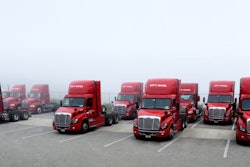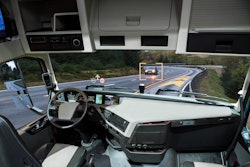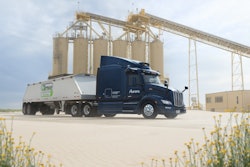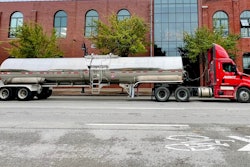Fleet leaders entered 2025 expecting the freight market to stabilize. Instead, it’s tightening further. Freight rates continue to decline. In the spot market, average rates have dropped over 9% since January, according to DAT Freight and Analytics.
Meanwhile, operating costs are being driven higher by global tariffs and inflation. According to Uber Freight, every 1% increase in tariff rates translates to a 0.15% to 0.25% drop in truckload freight demand. With tariffs now ranging between 18% and 28%, the analysis indicates that truckload demand could decline by as much as 6% this year.
At the same time, costs — especially for new equipment — are climbing steeply. The 25% import duty on trucks and parts has pushed many fleets to delay or cancel purchases. In May, trailer order cancellations hit 37.6% of gross orders, the highest in 12 months and nearly double April’s 20% rate, according to FTR Transportation Intelligence.
FTR also reports that June Class 8 tractor orders were down 32% year-over-year.
With profit margins being compressed from both directions, efficiency is no longer a strategic advantage; it’s a survival tactic. In this landscape, operational waste is too expensive to tolerate. Custom mobile apps for drivers are emerging as a proven way to reduce costs, increase productivity, and improve service.
Here are five ways leading fleets are deploying them to take control.
Digital onboarding
Driver turnover remains one of the most significant challenges in the trucking industry, particularly when revenue is tight. According to the American Trucking Associations, it costs more than $8,000 to replace a single driver. Many of these costs stem from mismatched expectations, unclear training, and avoidable errors made early on.
Knight-Swift Transportation tackled this issue head-on by reimagining its onboarding process around a mobile-first approach. The carrier integrated its KT Mobile app, built on the Eleos platform, into driver training.
Instead of relying on passive classroom sessions, new drivers now get hands-on experience with the tools they’ll use every day. They log duty statuses, complete digital inspections, upload documents, and navigate workflows—all on the same devices they’ll carry in the truck.
This real-world training produces better results. Drivers become confident and competent faster. Within eight weeks, Knight-Swift measured a 12% reduction in digital form errors, a key indicator of onboarding effectiveness.
Training that mirrors real-world work reduces early attrition, builds confidence, and enables new hires to contribute to fleet performance from day one.
Smart trip planning
Time lost to poor planning is rarely recovered. Every detour, delay, or hours-of-service issue reduces a driver’s efficiency and a fleet’s bottom line. When margins are already razor-thin, these losses become unacceptable and can hurt your bottom line.
Custom driver apps can address this by centralizing essential trip planning tools in a single interface that integrates:
- Real-time HOS visibility
- Route guidance
- Weather alerts
- Fuel pricing data
- Parking availability
- And more
For instance, a visual HOS countdown can alert drivers when drive time is running low. This proactive prompt helps avoid last-minute parking hunts and HOS violations by encouraging breaks before drivers hit their limits.
Trip planning functions support driver flexibility while maintaining dispatcher oversight and control. Drivers can customize routes within safe parameters, improving morale and compliance without compromising efficiency.
On average, drivers spend 56 minutes every day searching for a parking spot, according to research by the American Trucking Associations, subtracting 12 percent of their annual income from mileage-based pay models.
With truck parking shortages continuing to worsen, integrating with third-party reservation tools can help drivers secure spots ahead of time, thereby minimizing downtime, unsafe stops, and missed delivery windows.
In today’s market, thoughtful trip planning isn’t just a convenience—it’s a cost-saving necessity.
Communication tools
Unclear communication is one of the most persistent sources of inefficiency in the trucking industry. Missed instructions, outdated updates, or misunderstood assignments can result in significant costs for fleets, including lost time, service failures, and driver frustration.
Fleets like Hirschbach are tackling this by consolidating all key communication functions into a single, driver-friendly app interface. Headquartered in Dubuque, Iowa, Hirschbach is one of the largest truckload fleets, operating over 3,000 trucks and managing approximately 4,000 drivers across 18 locations.
Using its custom app, Hirschbach provides modular dashboards that serve as each driver’s mission control. Instead of toggling between different systems or calling dispatch for simple updates, drivers have everything they need at their fingertips, including:
- To-do lists
- Message threads
- Load assignments
- Weather updates
- Facility-specific documentation
Fleet managers also benefit. They can send targeted messages based on role, location, or urgency, thereby reducing noise and making sure important messages get through.
These communication tools go beyond logistics. They support morale by including:
- Language toggles for non-English speakers
- Customer facility maps
- Policy update videos
- Digital HR resources
The result is a better-informed, more confident workforce that spends less time calling dispatch and more time delivering freight.
Custom workflows
Shippers today demand precision. Whether delivering pharmaceuticals, groceries, auto parts, or industrial goods, they expect fleets to meet specific handling and documentation protocols.
A one-size-fits-all mobile app won’t cut it.
That’s why Chattanooga, Tenn.-based U.S. Xpress, one of the largest truckload carriers, relies on dynamic, load-specific workflows integrated into its driver app. Once a load is assigned, the company’s app prompts drivers with:
- Barcode scanning protocols
- Temperature monitoring instructions
- Special PPE requirements
- Dock entry procedures
- Facility-specific safety forms
These workflows are built and managed using its vendor platform’s App Editor tool, which allows operations teams to update workflows independently, without requiring a developer or IT support.
This capability lets fleets adapt quickly. If a major shipper changes requirements, the app can be updated across the fleet immediately. That agility protects compliance, reduces service failures, and improves shipper satisfaction across multiple verticals.
Custom workflows also reduce the need for manual training and back-and-forth between drivers and dispatch, further increasing productivity.
Instant scanning
Paperwork delays aren’t just frustrating—they cause financial harm. When delivery confirmation, BOLs, or inspection records are late, billing slows down, driver pay gets delayed, and back-office tasks pile up.
Custom driver apps enable fleets to digitize these steps in real-time. Drivers can:
- Scan and upload documents at the point of delivery
- Capture customer signatures
- Verify that all data fields are complete before submission
This ensures clean, complete documentation from the outset, streamlining invoicing, payroll, and compliance reviews. Documents are fed directly into connected systems, such as accounting, HR, and safety management, reducing manual entry and clerical errors.
With faster document turnaround, fleets improve cash flow and eliminate the paper trail that traditionally slows down business processes.
For billing teams, the benefit is twofold: fewer corrections and faster payments. For drivers, it means more accurate paychecks and fewer disputes. And for safety and audit teams, better data fidelity reduces risk exposure.
The case for a mobile-first strategy
Custom driver apps are no longer a “nice to have.” They’re an essential tool for operating in today’s volatile freight environment.
From onboarding to trip planning, communication, and compliance, mobile technology enables fleets to digitize workflows, reduce waste, and improve performance across the board.
More importantly, these apps empower drivers, giving them the clarity, confidence, and tools they need to succeed. When drivers are equipped with the right mobile tools, they become more productive, more engaged, and more likely to stay.
Are your drivers operating with outdated systems, or are they equipped with the necessary tools to thrive? In 2025, the answer to that question may determine whether your fleet survives the next downturn or leads the rebound.










